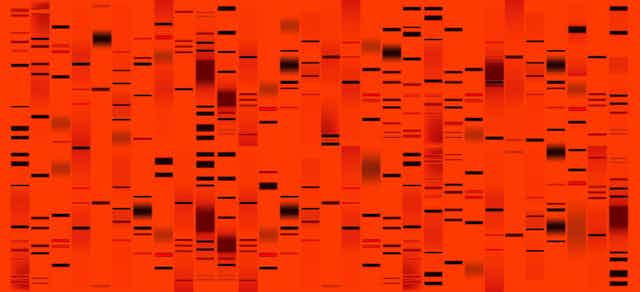The cellular processes involved in gene regulation can be unexpectedly complicated. The expression of genes — the when, where and how much of gene activity — underlies all of biology, but is surprisingly poorly understood.
A recent paper published by our research group generates as many questions as answers, but gives some explanations to possible mechanisms underlying the tangle of gene function. And notably, this published research shouldn’t exist, given the way we generally fund and support scientific research.
Complexity and genetic regulation
Biological complexity — the gloriously complicated and convoluted living world around us — is driven by regulation and specificity.
Essentially, every cell in a multicellular organism has the same set of genes known as their genome. What gives cells their unique identity — what makes a skin cell a skin cell and not a muscle cell — is their specific set of genes that are turned on or off. This regulation process is incredibly specific but frustratingly messy, and follows staggeringly tangled webs of rules.
This complexity makes the details of regulation of gene activity one of the great unknowns of modern biology.
In our paper, we explore how chromosomes physically interact and share information, how that sharing substantially modifies gene expression, and how that modification varies drastically between individuals. All three of these points explain some of the complexity in gene expression, but all three have been largely ignored in conventional modelling of gene regulation.

Geneticists have been taught that chromosomes are independent, don’t modify each other’s expression and that gene expression is similar between individuals. Except they aren’t, they do and it isn’t.
Chromosomal communication
In a process called transvection, pairs of chromosomes physically couple, modifying the expression of the genes they contain. We studied the phenomena in fruit flies using an unusual genetic situation we had created by pairing a series of chromosomes with small genetic deletions that inactivate a gene with wild, functional chromosomes.
Other labs have shown that chromosome pairing is part of normal gene regulation and development. But pairing errors similar to the ones in our study do occur, and they drive at least one type of human cancer.
Transvection is a widespread process and a powerful example of the hidden complexity of gene regulation.
It is also an example of research we would not have pursued if not for some uncommon direction and mentoring Thomas Merritt, a co-author of this article, received just before starting his own lab.
Our transvection project started as a failed experiment while Merritt worked in evolutionary geneticist Walt Eanes’s lab at Stony Brook University. As part of a study on metabolic interactions in flies, Merritt had edited a gene to produce a specific level of protein activity. Although the editing worked, there was much higher than expected levels of protein and gene activity. The experiment had failed.
Fortunately, Eanes explicitly guided researchers under his mentorship to pay attention to the unexpected, including failed experiments, and use them as an opportunity to question assumptions.
Two decades later, working alongside other scientists, we’re still finding new complications in genetics.

Failed experiments and scientific assumptions
That initial experiment had failed — but it had done so for a very interesting reason. That failed experiment, and the series of studies that followed it, showed that what geneticists typically think of as “independent” chromosomes actually interact with each other through direct physical connections.
That failed experiment illuminated a world of complex regulatory control. Not only do genes have incredibly complex on/off switches, these switches sometimes work across and between chromosomes.
Handled well, these unexpected failures in the lab pushed us to question the assumptions that led to the unexpected result. Here, the failed experiment forced us to rethink the independence of chromosomes.
Our further studies explored how this genetic conversation was dynamic, changed in response to the environment and differed between individuals.
Individual variation
The dynamic gene regulation and individual variation that allows multicellularity is also a central player in disease and individuality. For example, why do some people, but not others, respond to cancer treatments or even fall victim to cancer in the first place?
A better appreciation of individual variation is one of the major advances of our paper. Knowing that the amount of communication between chromosomes varies substantially across individuals and our work begins to shed light on the genes and mechanisms behind that variation.
These are important steps towards a more complete understanding of gene regulation and the misregulation that leads to diseases like cancer.
Dynamic science
Science advances when scientists push boundaries and explore, not when we repeat or timidly inch forward. Too often we try to avoid or prevent failure. Funding agencies may also hesitate to fund projects seen as risky.
Science needs a culture that promotes risk and exploring the unexpected.
And while we turn to science to address emerging crises, we are not supporting the necessary scientific development. Think of the increasingly frequent climate disasters, the challenges of feeding an exploding global population, the ongoing global pandemic and cancer.
Read more: Doctors are drowning in a tsunami of liver disease and cancer
All of these issues will require novel solutions and dynamic approaches that scientific funding agencies should acknowledge and support.
Breakthroughs in understanding require dynamic science and scientists who are supported to explore, ask unusual questions and, occasionally, fail in the lab. Sometimes the most important results from an experiment are the questions it forces us to ask.

